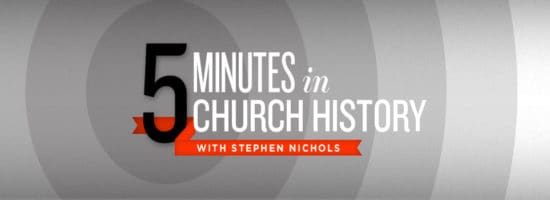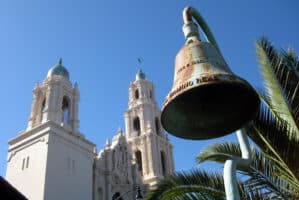
Dr. Stephen Nichols takes us to the Royal Road, a 600-mile trail that connects 21 missionary outposts in California.
 On this episode, as well as all of the episodes this month, we will be recording on location in California. I was going to call these episodes “California Dreaming.” I don’t know about that, but what I do know is that we’ll be looking at some formative moments in American church history, and all of them happened on location here.
On this episode, as well as all of the episodes this month, we will be recording on location in California. I was going to call these episodes “California Dreaming.” I don’t know about that, but what I do know is that we’ll be looking at some formative moments in American church history, and all of them happened on location here.
First up is not so much a place, but places on a trail known as the “El Camino Real.” This is also known as the “Royal Road.” It is a six-hundred-mile trail that connects the twenty-one missions established by Franciscan missionary monks in California. It stretches all the way from San Diego to just north of San Francisco Bay. These missions were first established in 1769, constructed all the way up the Royal Road, and thrived until 1833. In fact, four major cities evolved around these missions here in California—San Diego, San Jose, San Francisco, and Los Angeles.
The mission in Los Angeles is named Mission San Fernando Rey de España. It was number seventeen of twenty-one, and it was established in 1784. Like all of these other missions, it has arched walkways and it has beautiful gardens and fountains. In fact, I’m sitting near a fountain right now.
In this particular mission, we have the burial place of Bob Hope. But this is church history, not comedy history, so we’ll leave that for another podcast. This mission also has an entire set of the works of our friend from the Middle Ages: Thomas Aquinas. These missions were established by these Franciscan monk missionaries to convert the Native Americans here to Roman Catholicism. They were under Spain’s governance. At the time, Mexico was under Spain’s control, and these missionaries came up from Mexico and established one mission after another.
So what happened to them? In 1821, Mexico gained its independence from Spain and that cut off some of the funding and some of the protection that these missions enjoyed. Earlier than that, France had gained the upper hand on Spain and the King of Spain was taken into prison. That impacted the funding as well.
Currently, the missions are a mix of parish churches and museums. Some of them are run by the Roman Catholic church, some are California state parks. Many of them are national historic landmarks. But what did they do back between the years of 1769 and 1833? Well, there was quite a flow of goods and services among these twenty-one missions. Certain missions were designated for certain tasks. Some had vineyards, some had other elements of animal husbandry. There were many that were given to farming. They were also educational centers, and they also served as early hospitals. There were goods that were passed back and forth between these missions. Various Franciscan monks were trained at one mission and sent off to work at another. There was quite a network of travel between these missions.
What we find here is something we don’t often talk about in terms of the roots of American Christianity. We often talk about the New England Puritans, but we also have to remember that in addition to the Puritans and those that represented the branches of the Reformation, we also have these Roman Catholic settlements here in what would come to be the United States of America.
So, here in California, we have the El Camino Real, this royal road that connected the twenty-one missions like the mission right here in the “City of Angels,” Los Angeles, California.
Stay connected with 5 Minutes in Church History by getting the weekly podcast on iTunes, SoundCloud, or via RSS. You can also subscribe to the blog via RSS and follow us on Twitter and Facebook.
(This podcast is by Ligonier Ministries. Discovered by Christian Podcast Central and our community — copyright is owned by the publisher, not Christian Podcast Central, and audio is streamed directly from their servers.)